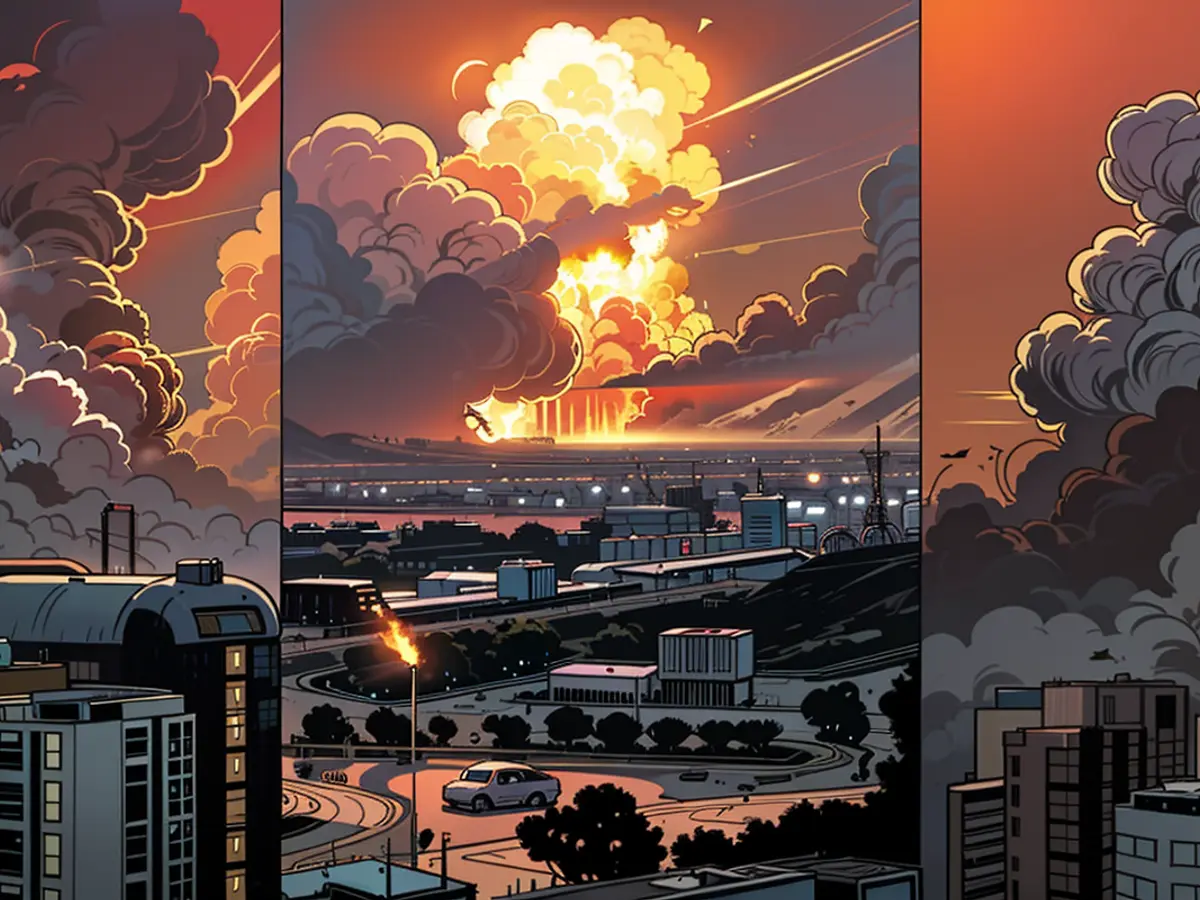CNN embarks on Israeli warship for deadly assault on Yemeni port overseen by Houthi rebels
The sun-kissed apricot desert of Saudi Arabia drifts past my right side, while the Egyptian coastline appears to my left. Then, an enormous F-35 fighter jet fills my tiny screen as I embark on this extraordinary journey. I am with the Israel Defense Forces (IDF), becoming the first foreign journalist to tag along on a combat mission beyond Israel's boundaries, aboard a fighter jet refuel tanker.
Ever since Hamas initiated their October 7 attack the previous year, Israel has been embroiled in an escalating conflict. It's not just confined to Gaza, but also extends to Lebanon with Hezbollah and Yemen with the Houthis, who have begun launching long-range attacks at Israel's major population centers. Syria and Iran have also become battlegrounds for Israel, as they too find themselves under attack.
The Israeli response to these attacks has resulted in the loss of nearly 42,000 lives in Gaza and more than 1,000 lives in Lebanon. Bombardments in Yemen have also wreaked havoc on critical infrastructure in a war-torn nation that has long suffered as one of the world's worst humanitarian crises.
The details about our mission's destination remained unknown as I climbed the rickety ladder aboard the aircraft. I had no idea where I was headed or what secrets this IDF flight was about to unfold about their military operations.
Security regulations within the Israeli Air Force are air-tight, rendering cell phones and photojournalists as forbidden items. Lt. Col. Nadav Shoshani, the IDF spokesman accompanying me, was equally prohibited from carrying a phone.
Other than the cockpit, I was given unrestricted access to the aircraft, provided that its commanders remained anonymous. Despite the absence of cameras, this rare chance granted me an opportune glimpse into the lives of soldiers on the front lines, battling on multiple fronts.
Retraced memories of the aircraft's former life as a commercial airliner lingered through lingering hints, like the sexist iconography of a woman's face on the call buttons. Yet the plane underwent a remarkable transformation, as it was converted into an Israeli tanker equipped with massive, pressurized fuel tanks.
The lengthy reconstruction process entailed the removal of passenger seats, while making room for the tanker's long body. The tanks contained the essential fuel required for Israel to project its might.
Our refueling mission, covering a distance of 1,200 miles (1,500 kilometers), was the Israeli Defense Forces' longest-range combat mission since the historic raid on Tunis in 1985.
Prime Minister Benjamin Netanyahu's words from his UN General Assembly speech echoed in my mind, as Lt. Col. Shoshani reminded me of Netanyahu's conviction, "There is no place my nation cannot reach."
For more than an hour and a half, Israeli F-35 fighter jets, each valued at more than $100 million, shadowed the 707 tanker, inching towards its fuel pipe.
The squadron commander, with over a decade of experience in refueling missions, led the way, managing his 3D goggles and expertly maneuvering the nozzle towards the gas-guzzling jets.
No task is without its challenges, the commander explained. Their primary challenge was ensuring proper fuel loading and timing, carrying out their mission to the minute, so the jets would arrive at their target with a full tank when intel suggested it was the optimal time for an attack.
Upon viewing the mission's map, I realized we were en route to Hodeidah Port in Yemen, controlled by Houthi rebels and backed by Iran. Lt. Col. Shoshani revealed the precise reason for our mission; over the past two weeks, the Houthis had launched three long-range missiles, all intercepted near Tel Aviv.
Starting with attacks on shipping in the Red Sea, the Houthis claimed they were acting out of solidarity with Palestinians in Gaza. Their flag bore the phrases, "Death to Israel, A Curse Upon the Jews." Specialized experts suggested that the global fight in the name of Gaza's Palestinians lent support to the group in Yemen and awarded them international acclaim.

The Houthis claimed that their newest missile, launched late Saturday, was targeted at Prime Minister Netanyahu upon his return to Israel from New York. An impact in this area could have resulted in catastrophic civilian casualties, thereby necessitating our mission.
As the last of the F-35s detached from the fuel pipe, the squadron commander visibly relaxed, removing his goggles and stretching wearily. Each jet required approximately 3 minutes of contact, requiring intense focus from the crew.
We circled, waiting for the fighter pilots to execute their attacks. Any ground assault could deplete their fuel supply as they evaded enemy fire and sought refuge, requiring a refueling to return to base.
Twenty minutes later, we were heading north, without the need for additional fuel.
I asked the lead pilot on the tanker about the obstacles of such a mission and how they felt about the collateral damage. We do not want to harm civilians, he responded, and we rely on all available intelligence to prevent civilian casualties.
I pointed to the high fatalities in Gaza and Lebanon from Air Force strikes. They were targeting the Houthis, he explained, as they were firing missiles at our civilians, jeopardizing them.
Upon our safe return to southern Israel, news of the strike was swiftly disseminated. The Houthi TV channel broadcast images of massive flashes of fire and smoke from Hodeidah Port.
The IDF reported that their targets were "power plants and a seaport in the areas of Ras Issa and Hodeidah," adding that the Houthis exploited the port to transfer weapons to the region and vital supplies.
According to officials from the Houthi group, the F-35s I observed being refueled carried out strikes on a power station and fuel storage facility in Hodeidah, leading to the death of a port officer and three engineers.
Lt. Gen. Herzi Halevi, the Chief of Staff for the IDF, issued a statement following the attack: "We're well-versed in reaching great distances, we're capable of reaching even further, and we're experts in delivering pinpoint accuracy."
Halevi continued, stating, "This isn't merely a message; it's an action that conveys a message of its own."
During the flight, Shoshani shared with me that the message was intended for Iran as well, serving as a warning that while Israel anticipates retaliatory strikes from Hezbollah in Lebanon, they hope to keep Iran out of the conflict.
This incident wasn't merely an illustration of the lengths Israel is willing to go to retaliate against its adversaries, but live proof that formerly hidden threats are beginning to resurface, and Israel's mission to counteract them is becoming more widespread.
The escalating conflict in the Middle East extends beyond Israel's borders, involving countries such as Lebanon with Hezbollah and Yemen with the Houthis, who have targeted Israel's major population centers. The world watches as Israel responds to these threats, leading to significant casualties in Gaza and Lebanon.
In response to the missile attacks from Yemen, the Israeli Defense Forces (IDF) embarked on a long-range combat mission, refueling F-35 fighter jets over the Middle East, aiming to hinder the Houthis and their Iranian backers.









